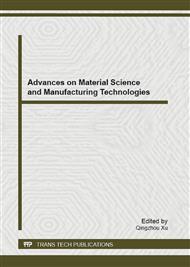[1]
Y. L. Zhang., M. Sun. Manual of Rubber Varieties and Performance [M]. Beijing: Chemical Industry Press, 2007, pp.262-263.
Google Scholar
[2]
M. M. Sun., B. Zhang., X. G. Zhang., et al. Development of high-temperature-resistant and low-density polysulfide sealants [J]. Conference of the China Aviation Society, vol. 27, (2007), pp: 1-7.
Google Scholar
[3]
S. D. Cao. Effect on the performance of molecular weight distribution and molecular weight of liquid polysulfide sealants with -SH end-groups [J]. Rubber Industries, 2 (1993), pp:77-81.
Google Scholar
[4]
X. W. Zhang. Modified polysulfide hollow-glass sealants [J]. Elastomer, vol. 11, no. 5, (2001), pp: 3741.
Google Scholar
[5]
J. B. Yan. Modification of the polysulfide sealants [J]. World Rubber Industries, vol34, no12, (2007), pp: 23-25.
Google Scholar
[6]
Y. Q. Lin, L. C. Nie, R. Y. Liu, et al. Research on the effective and mildew-proof polysulfide sealant [J]. Material Engineering, no. 7, (2007), pp: 44-47.
Google Scholar
[7]
G. Liu., P. B. Qin., S. H. Wu. Research on brand-new high-temperature-resistant and oil-resistant sealants [J]. China Adhesives, vol. 18, no. 8, (2009), pp: 36-38.
Google Scholar
[8]
M. M. Sun., B. Zhang., X. G. Zhang., et al. Effect of fillers on the performance of polysulfide sealants [J]. Chemistry and Adhesion, 2010, vol. 32, no. 01: pp: 9-12.
Google Scholar
[9]
Y. Y. Wang., J. Y. Meng. Effect of Thermo-oxidative Ageing on Aviation Polysulfide Sealants [J]. Applied Mechanics and Materials, vols. 152-154 (2012) , pp: 28-33.
DOI: 10.4028/www.scientific.net/amm.152-154.28
Google Scholar
[10]
S. H. Wu., X. S. Yi., P. B. Qin., et al. Aging mechanism of polysulfide sealants soaked in aviation kerosene [J]. Journal of Aeronautical Materials, vol. 27, no. 6(2007), pp: 79-82.
Google Scholar
[11]
T. W. Andreas. RILEM TC190-SBJ: Development of recommendation on novel durability test methods for wet-applied curtain-wall sealants [J]. Material and Structures, vol. 41, (2008) pp: 1473-1486.
DOI: 10.1617/s11527-008-9418-2
Google Scholar
[12]
RILEM Technical Committee (T. W. Andreas). Recommendation of RILEM TC190-SBJ: Service-life prediction of sealed building and construction joints [J]. Material and Structures, Vol. 41, (2008) , pp: 1497-1508.
DOI: 10.1617/s11527-008-9420-8
Google Scholar
[13]
W. J. Hu., Z. F. Liu., Y. M. Chen. Thermo-oxidative accelerated aging and service-life predicting modes for rubber [J]. Rubber Industries, no. 100, (2004) , pp: 42-46.
Google Scholar
[14]
K. Zhang., Y. H. Huang, Y. Ma, et al. Accelerated aging and service-life predicting modes for rubber [J]. Chemical Propellant and Polymer Materials, no. 06, (2004), pp: 44-48.
Google Scholar
[15]
J. A. Zhong., Q. M. Zhong., Y. B. Chen. Experimental studies on aging life of the o-ring of rubber [J]. Synthetic Materials: Aging and Applications, 1998, 1: 1-4.
Google Scholar


